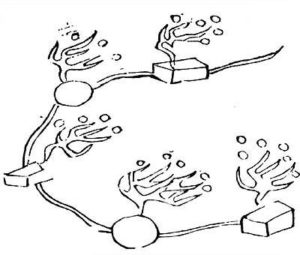I’ve been “following my nose” looking for some early historical uses of victim operated or booby trap IEDs and found an interesting reference to an intriguing Chinese IED of the 14th century. While there are references to both command and victim operated IEDs in China a century earlier (connected to war against Kubla Khan’s Mongols) there is a Chinese text called the Houlongjing (Fire Dragon Manual) from around 1350 which contains some fascinating detail of booby trap IEDs and their initiation system.

The Huolongjing describes IEDs constructed from iron spheres filled with gunpowder, and within a range of other IEDs describes two of particular note, translated as the “ground thunder explosive” and the “self-trespassing” types. The text says the following:
These mines are mostly installed at frontier gates and passes. Pieces of bamboo are sawn into sections nine feet in length, all septa of the bamboo being removed, except the last; and it is then bandaged round with fresh cow hide tape. Boiling oil is next poured into the tube and left there before being removed (I’m guessing these measures are to waterproof the container.) The fuse starts from the bottom of the tube and the explosive (blackpowder) is compressed into it to form an explosive mine. The powder fills up eight tenths of the tube, while lead or iron pellets take up the rest of the space:, then the open end is sealed with wax. . A trench five feet in depth is dug (for the device to be concealed). The fuse is connected to a firing device which ignites when disturbed.
The Houlongjing then describes an initiation mechanism for this device as consisting of a steel wheel, which directed sparks onto the connection of fuses running to the buried explosive charges. That alone is interesting, but a further Chinese document of 1606 adds detail, about a flint connected to the steel wheel and the steel wheel being driven by a weight drive. There appears to have been some sort of pin release caused by the victim stepping on a flexible board, which releases a weight on a string. The string is wrapped around the axle of the steel wheel or wheels , to which a flint is attached. The flint rotates round striking a steel, causing a spark, which initiates the IED.
There’s a connection here to the invention of the wheel-lock mechanism by Leonardo da Vinci in about 1500. I’m pretty certain that as well as being used as the initiation mechanism for muskets, wheel-locks began to be used as IED initiation systems in the late 1500s. Of course too there is a link between the weight drive of the Chinese IED and the development of weight driven clocks with escapements. Technology development is interesting when various aspects run in parallel.
There are some detailed diagrams of the initiations systems in the Houlongjing but I confess I can’t yet make head nor tail of them.
